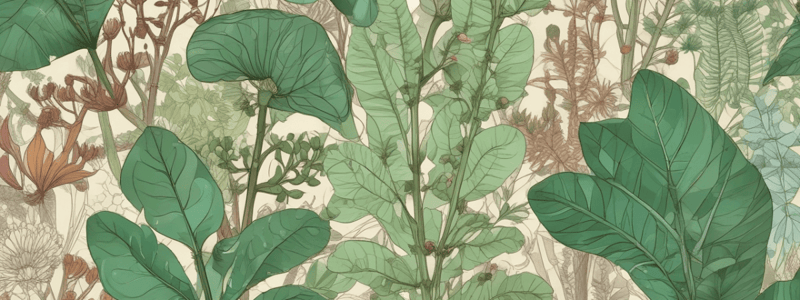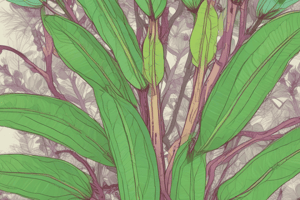Podcast
Questions and Answers
What is the primary force behind the transportation of water from the roots to the leaves in a plant?
What is the primary force behind the transportation of water from the roots to the leaves in a plant?
What is the term for the process of water moving upwards through the plant?
What is the term for the process of water moving upwards through the plant?
Under what conditions would the rate of transpiration be lowest?
Under what conditions would the rate of transpiration be lowest?
What is the purpose of wilting in plants?
What is the purpose of wilting in plants?
Signup and view all the answers
What is the purpose of using a potometer?
What is the purpose of using a potometer?
Signup and view all the answers
What happens to the water potential gradient between the leaf and the air when the air is dry and humidity is low?
What happens to the water potential gradient between the leaf and the air when the air is dry and humidity is low?
Signup and view all the answers
What is the result of the rate of water loss through transpiration exceeding the rate of water uptake from the roots?
What is the result of the rate of water loss through transpiration exceeding the rate of water uptake from the roots?
Signup and view all the answers
What does the movement of the bubble in the potometer tube indicate?
What does the movement of the bubble in the potometer tube indicate?
Signup and view all the answers
What is the primary function of stomata in the process of transpiration?
What is the primary function of stomata in the process of transpiration?
Signup and view all the answers
Which cells are responsible for regulating the opening and closing of stomata?
Which cells are responsible for regulating the opening and closing of stomata?
Signup and view all the answers
What is the driving force behind the movement of water upwards in the xylem?
What is the driving force behind the movement of water upwards in the xylem?
Signup and view all the answers
What is the result of the air outside the leaf having a lower water vapor concentration and a lower water potential compared to the inside of the leaf?
What is the result of the air outside the leaf having a lower water vapor concentration and a lower water potential compared to the inside of the leaf?
Signup and view all the answers
What is the role of the internal leaf structure in facilitating transpiration?
What is the role of the internal leaf structure in facilitating transpiration?
Signup and view all the answers
What is the effect of having more stomata and wider openings on the rate of transpiration?
What is the effect of having more stomata and wider openings on the rate of transpiration?
Signup and view all the answers
What is the result of water evaporation from the leaf surface during transpiration?
What is the result of water evaporation from the leaf surface during transpiration?
Signup and view all the answers
What is the significance of transpiration in maintaining the plant's health and functionality?
What is the significance of transpiration in maintaining the plant's health and functionality?
Signup and view all the answers
Study Notes
Transpiration
- Transpiration is the process of water vapor loss from plant leaves, crucial for the overall movement of water through the plant and various physiological functions.
- Water loss occurs primarily through tiny openings called stomata, located on the undersides of leaves, regulated by specialized cells known as guard cells.
- When stomata are open, water vapor diffuses out of the leaf into the surrounding air due to the lower water vapor concentration and water potential outside the leaf.
Structure of Leaves
- Leaves have a large internal surface area due to interconnecting air spaces between mesophyll cells, increasing the contact between moist cell walls and air spaces, promoting water evaporation.
- The size and number of stomata also contribute to the rate of transpiration, with plants having more stomata and wider openings experiencing higher rates of water loss.
Transpiration Pull
- The movement of water upwards in the xylem is driven by the transpiration pull or cohesion-tension theory, creating a negative pressure gradient within the xylem.
- This negative pressure pulls on the water column, generating a cohesive force between water molecules due to hydrogen bonding, forming a continuous column from the roots to the leaves.
Factors Affecting Transpiration
- Temperature: hotter temperatures increase the kinetic energy of water molecules, making it easier for them to evaporate and diffuse away from the leaf.
- Wind: windy conditions remove water vapor from the space around the leaf, keeping the water potential of the air lower and promoting water vapor diffusion out of the leaf.
- Humidity: humid conditions reduce the water potential gradient between the leaf and the air, slowing down water vapor diffusion out of the leaf.
Wilting
- Wilting occurs when the rate of water loss through transpiration exceeds the rate of water uptake from the roots, causing cells to lose water and become flaccid.
- Wilting is an adaptive response to water stress, aiming to reduce the surface area exposed to transpiration, conserve water, and enhance survival chances.
Measuring Transpiration
- A potometer is a device used to measure transpiration and how different factors affect it.
- The device measures the movement of a bubble of air in a tube connected to a plant stem, indicating the rate of water evaporation from the leaves.
Studying That Suits You
Use AI to generate personalized quizzes and flashcards to suit your learning preferences.
Description
Learn about the process of transpiration in plants, its role in water movement, and how it's regulated by stomata and guard cells.



